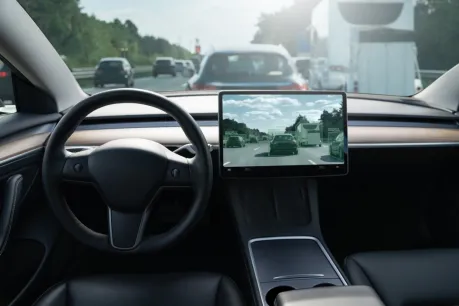Tesla Car Accident Lawsuits: What You Need to Know

Injured?
Tesla’s revolutionary electric vehicles (EVs) and autonomous driving technologies have reshaped the automotive industry—but they also introduce unique risks and legal complexities.
In 2024, Tesla recalled over 5 million vehicles due to serious risks and manufacturing mishaps—that’s more recalled vehicles than any other car manufacturer in the U.S. Such statistics may give consumers pause on whether Tesla values the safety of its drivers.
If you’ve been involved in an accident with a Tesla vehicle, contact Morgan & Morgan for a free case evaluation. If an unsafe vehicle was rushed to market, put on the road, and placed you in harm’s way, you may be entitled to compensation.
Accidents Involving Tesla Vehicles
Tesla’s vehicles are renowned for their innovative features, but they are not immune to accidents. In fact, as the adoption of Tesla’s technology grows, so does the number of incidents reported. Studies have shown that while Tesla’s advanced driver assistance systems (ADAS) aim to reduce human error, they often introduce new types of risks.
Tesla Autopilot, a Level 2 ADAS, was released in October 2015, and the first fatal crashes involving it occurred less than one year later.
One of the most common factors contributing to Tesla-related accidents is the over-reliance on its Autopilot and Full Self-Driving (FSD) features. While these systems are designed to assist drivers, they require constant human supervision, a detail often misunderstood by users. Additionally, technical malfunctions, such as sudden braking, failure to detect obstacles, or software glitches, have been cited in numerous crashes.
As of October 2024, there have been hundreds of nonfatal incidents involving Autopilot and fifty-one reported fatalities, forty-four of which NHTSA investigations or expert testimony later verified and two that NHTSA's Office of Defect Investigations verified as happening during the engagement of Full Self-Driving (FSD).
Tesla drivers are not the only ones at risk. Other road users, including pedestrians, cyclists, and passengers in other vehicles, may find themselves in harm’s way due to these accidents. The complexity of these incidents often requires in-depth investigations, including reviews of software logs and system performance.
One real-life example of a fatal Tesla car accident involved a Tesla Model 3 driving in Delray Beach, Florida in March of 2019. The Tesla was on autopilot and struck a semi-trailer truck that was making a left-hand turn out of a private driveway. The Tesla underrode the trailer, and the force of the impact sheared off the greenhouse of the Model 3, resulting in the death of the Tesla driver.
After the crash and underride, the Tesla continued to drive for approximately 1,680 ft before coming to rest in the median. Although the airbags did not deploy following the collision, the Tesla's driver remained restrained by his seatbelt. Emergency response personnel arriving at the scene determined the driver's injuries were fatal.
Legal Issues Surrounding Tesla’s Autopilot and Self-Driving Features
Tesla’s Autopilot and Full Self-Driving (FSD) features have sparked debate and legal scrutiny. These systems, while innovative, have been linked to numerous accidents. Key legal issues include:
Misleading Marketing
Tesla’s Autopilot and FSD features have been a focal point of the brand’s marketing, but they have also led to considerable legal scrutiny. The term “Autopilot,” for example, implies a level of automation that many associate with a hands-off driving experience. In reality, Tesla’s own documentation states that these features require active driver engagement. This discrepancy has led to confusion and, in some cases, tragic outcomes.
Liability Questions
From a legal perspective, determining liability in an accident involving Tesla’s self-driving features is particularly challenging. In traditional accidents, fault often lies with the driver. However, in Tesla-related incidents, fault could be shared between the driver, Tesla’s software, or even third-party manufacturers of components used in the vehicle. Notable lawsuits, such as the fatal crash in Mountain View, California, have raised critical questions about Tesla’s responsibility to ensure their systems function safely and reliably.
Notable Lawsuits
Courts are also beginning to see cases that test the boundaries of product liability law. For instance, if Tesla’s software fails to prevent a collision, is Tesla responsible for the damages? Or does the burden fall on the driver for failing to intervene? These are complex legal questions that require experienced legal counsel to resolve.
Cases like the Tesla Autopilot fatal crash in Mountain View, California have set legal precedents, holding Tesla accountable for system malfunctions. In March 2018, Walter Huang, a 38-year-old Apple employee, was commuting to work in his Tesla Model X when his vehicle swung left at the and crashed into a median barrier at over 70 mph. The collision fully crushed the front of the vehicle, which then careened into two other vehicles before coming to a stop. Huang was transported to a local hospital where he later died.
After nearly five years of litigation, Tesla settled a wrongful death lawsuit that alleged the company’s autopilot technology was responsible for the fiery highway crash.
Tesla Battery and Car Fire Incidents
Tesla’s electric vehicles rely on high-capacity lithium-ion batteries to deliver exceptional performance and range. While these batteries represent a technological leap, they also pose significant risks. Fires involving Tesla batteries, though rare, are uniquely dangerous. They burn at extremely high temperatures and are difficult for emergency responders to extinguish.
Battery fires can occur as a result of manufacturing defects, external impacts, or even software issues. Victims of such incidents may face severe injuries, extensive property damage, and emotional trauma. In these cases, legal action is not just about compensation; it’s about holding manufacturers accountable to ensure public safety.
If you or a loved one has been affected by a Tesla battery fire, there are important steps to take. First, seek immediate medical attention, even if injuries seem minor. Then, document the scene as thoroughly as possible, preserving any evidence of the fire or the vehicle’s condition. Finally, contact an attorney experienced in handling Tesla-related cases to explore your legal options.
Model-Specific Legal Concerns: Tesla Models S, X, and 3
Not all Tesla models are created equal, and different models present unique challenges when it comes to accidents.
Model S
Some Model S models have had electrical issues, including problems with the climate control, steering, and suspension systems. Other issues include faulty electric motors, warped brake discs, and door handles that don't pop out.
Model X
Some of the most common issues associated with Tesla’s Model X cars include autopilot failure, poor windshield visibility, faulty steering system, and unexpected acceleration, which have led to multiple recalls.
Model 3
A batch of Model 3 cars have been known to have the rear glass randomly crack without any impact damage, allegedly due to the body of the vehicle flexing. Other issues have included the vehicle shutting down while driving, loss of power, lock system malfunctions, and faulty touchscreens.
If you are pursuing a lawsuit, legal strategies may vary based on the vehicle model, requiring specialized expertise.
Legal Rights and Options After a Tesla Accident
Victims of Tesla-related accidents have the right to seek compensation for their injuries and losses. Understanding these rights, however, can be challenging given the complexity of the technology and the legal issues involved.
After a Tesla car accident, seek medical attention immediately. Your health and safety come first, but this also creates a medical record to document any injuries, which can be used as evidence in a personal injury claim.
Report the accident to law enforcement and Tesla. Request official copies of the reports for your own records.
Preserve all evidence, including vehicle data, photos, and witness statements.
In cases involving Tesla’s Autopilot, you can obtain the vehicle’s software logs, which can provide valuable insights into the system’s performance at the time of the accident. Working with a Morgan & Morgan car accident lawyer familiar with Tesla-related cases can make all the difference in navigating these steps effectively.
Tesla Autopilot Malfunctions: What to Know
Malfunctions in Tesla’s Autopilot system are a growing concern. These can include sudden braking, sudden and random acceleration, failure to detect obstacles or people, or incorrect lane changes.
Determining liability in these cases often requires collaboration with technical experts who can analyze the vehicle’s systems.
In many cases, Tesla’s logs and telemetry data are central to understanding what went wrong. An experienced lawyer can subpoena these records and work with engineers to build a compelling case. Legal action can also serve as a way to advocate for safer technology and improved oversight in the future.
How to Choose the Right Tesla Accident Lawyer
When selecting legal representation, consider:
- Experience: Choose a lawyer with a track record in handling Tesla-related cases.
- Technical knowledge: Attorneys must understand Tesla’s technology and the associated legal intricacies.
- Resources: A law firm like Morgan & Morgan has the expertise, resources, and dedication to take on Tesla and other large corporations.
If you’ve been involved in an accident with a Tesla vehicle, Morgan & Morgan is here to help. Our attorneys have the knowledge and experience to handle complex cases involving cutting-edge automotive technology.
With over 35 years of experience in car accident personal injury cases, we’ve recovered over $30 billion in the process. As the nation’s largest personal injury law firm, we have the size and resources to take on the biggest corporations, including Tesla.
If a faulty vehicle caused you harm, don’t bear the burden of someone else’s mistake. Contact us today for a free case evaluation.

We've got your back
Injured?
Not sure what to do next?
We'll guide you through everything you need to know.

